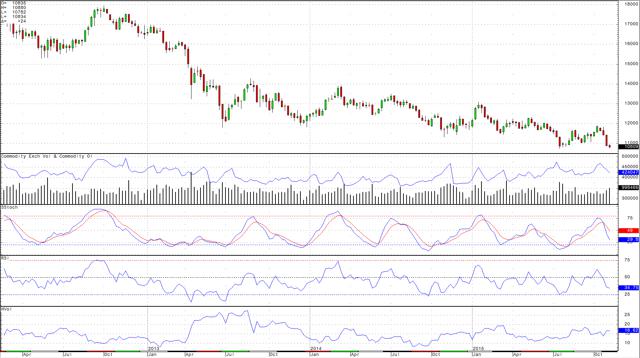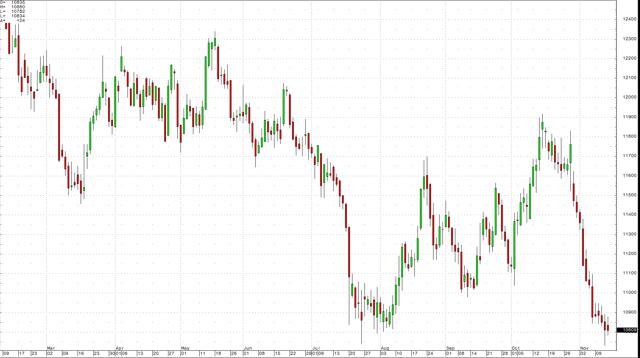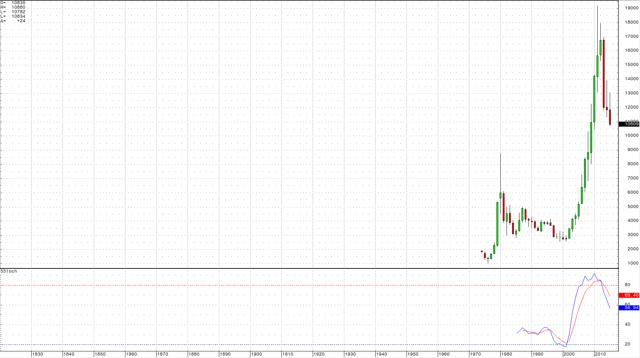Gold: On The Edge Of A Steep Cliff
- It's not just gold - metals look ugly.
- Abject price failure.
- How low can it go?
- Cheap money will create a golden opportunity.
- An event will move gold - The Fed or The Unknown.
It's not just gold - metals and commodities look ugly
Silver declined from $16.37 per ounce on October 15 to close last Friday at $14.23. It is down by $2.14, or just over 13% in one month. Platinum has imploded. On October 16, it was at $1026.80 per ounce. Last Friday, "rich man's gold" closed at $861.40 per ounce. The session's lows were just below at $860.50. A decline of over 16% resulted in a drop to the lowest level since December 2008.
Palladium fell from $724.95 on October 9 to close Friday at $540. The decline of 25.5% brings palladium within a stone's throw of the August 26 lows of $519.20 per ounce.
Precious metals did not move in a vacuum. Crude oil closed last Friday at $40.74 per barrel on the active-month December NYMEX futures contract. This is the lowest level since late August and less than $2 above contract lows, which were the lowest levels since 2008.
Copper fell to a new multi-year low at $2.1510 per pound on Friday, and closed last week only 1.1 penny higher. Grains moved to new lows on the week, and the list of losers included even more raw material markets. Gold has held up pretty well in the face of a strong dollar and falling commodity prices; it is still above $1000 per ounce. The question is, can it possibly stay here given ubiquitous weakness and new multi-year lows sweeping across almost every commodity market?
Abject price failure
Gold did make a new contract low by 70 cents on the December COMEX futures contract as it traded down to $1073 per ounce last Thursday. It came very close to a new multi-year low, but avoided that level for now.
(click to enlarge)

The continuous contract lows during the week of July 20 were at $1072.30 - just 70 cents below last week's lows. Gold bounced from its lows on November 12 and closed the week at $1083.40 per ounce. The weekly chart clearly highlights the fact that momentum in gold continues to be bearish and the yellow metal now sits on the edge of a cliff.
Gold began the fourth and final quarter of 2015 with a rally that took it up to $1191.70.
(click to enlarge)

As the daily chart illustrates, the rally just turned out to be yet another lower high in the four-year bear market in gold. Every single rally in gold since 2011 has resulted in abject failure and a lower low, and another one is coming soon.
How low can it go?
Given the moves in other commodity markets and the dollar, gold has held up well. However, I do not believe this will continue. While it displays an oversold condition on daily charts, the metal cannot ignore what is going on all around it. Other hard assets are dropping like flies; it is only a matter of time until gold joins the rout.
Given the historical mean level of inter-commodity spreads against silver and platinum, gold remains much too expensive at over $1000 per ounce. The long-term average of the silver-gold ratio at 55:1 implies a gold price of $782.65 per ounce. This ratio closed Friday at 76.13:1. The long-term mean level of the platinum-gold spread at a $200 premium for platinum over gold implies a gold price of $661.40 per ounce. This spread closed with gold trading at a premium of $222 to platinum last Friday.
The metal can go much lower from its current price. I believe that a price below $1000 is a no-brainer at this point. I further believe that gold needs to test the 1980 highs of $875 per ounce on a technical basis.
(click to enlarge)

The slow stochastic, a momentum indicator, on the yearly gold chart is negative, and the 1980 highs is certainly a target for support for the yellow metal.
Cheap money will create a golden opportunity
On a global basis, interest rates remain at historically low levels. A low interest rate environment generally is a positive for gold and other commodity prices. However, the dollar's strength has dominated the action in raw material prices. Low interest rates are a response to weak economic conditions around the globe. Central banks have artificially lowered rates to stimulate economies.
They have also employed other tools, like quantitative easing and purchases of all types of debt, to provide stimulus.
In the future, these moves and artificially low rates will come at a price. Cheap money chasing goods and services is bound to cause inflationary pressures around the globe. Inflation has been gold's best friend throughout history. Add to that exponential rates of population growth, and you have a situation where the world will find more people chasing finite goods with lots of cheap currency. It is a scary prospect.
While gold will likely drop to a new lower low and will trade in the triple digits, history tells us that it will once again become an attractive investment at lower levels. I am looking to buy the metal at prices below $900 per ounce. Gold will drop below average production cost levels, and declining production will strengthen its fundamentals and future prospects.
An event will move gold - The Fed or The Unknown
As I write this article on late Friday, November 13, news of the latest terrorist attack in France is trickling through the airwaves in the background. The attack is the latest reminder - not that we need one - that the world is a terribly dangerous place these days. At least two suicide attacks and one bombing near a stadium where France and Germany were playing a soccer match were responsible for the deaths of scores of innocent people. These types of events send fear and shock throughout the civilized world. In recent years, we have seen many of these types of attacks, although the latest one in Paris appears to be particularly heinous. In each case, gold has not attracted buying; it has not been a "flight to safety" asset around the world.
However, the attack in Europe is likely to result even worse economic conditions, as weak economies there must pay the expensive bills of protecting their citizenry from a faceless and anonymous enemy that is hard to identify before it is too late. It is also likely to drive more of a wedge between refugees from the Middle East and traditional citizens of European countries.
Recession or deflationary pressures are likely to continue to grip Europe.
What is most likely to move gold next is an interest rate rise in the United States. The Fed appears to be ready to ignite the "liftoff" of rates at their December meeting, as promised all year long. This will provide further support for the already bullish U.S. dollar, and could be the final straw for gold. I expect gold to move aggressively lower. Any rally like the one we saw at the beginning of October will attract selling and run out of steam. Gold is ready to fall off the end of the cliff on which it now sits. That fall is likely to come sooner rather than later.

0 comments:
Publicar un comentario